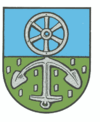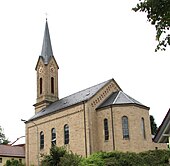Reipoltskirchen
| coat of arms | Germany map | |
|---|---|---|

|
Coordinates: 49 ° 38 ' N , 7 ° 40' E |
|
| Basic data | ||
| State : | Rhineland-Palatinate | |
| County : | Kusel | |
| Association municipality : | Lauterecken-Wolfstein | |
| Height : | 208 m above sea level NHN | |
| Area : | 7.48 km 2 | |
| Residents: | 353 (Dec. 31, 2019) | |
| Population density : | 47 inhabitants per km 2 | |
| Postal code : | 67753 | |
| Area code : | 06364 | |
| License plate : | KUS | |
| Community key : | 07 3 36 085 | |
| Association administration address: | Schulstrasse 6a 67742 Lauterecken |
|
| Website : | ||
| Local Mayor : | Ernst Eckert | |
| Location of the local community Reipoltskirchen in the district of Kusel | ||
Reipoltskirchen is a local church in the West Palatinate Kusel district in Rhineland-Palatinate . It belongs to the Lauterecken-Wolfstein association.
geography
The place is in the valley of the Odenbach in the north of the North Palatinate mountains . The Ausbacherhof, Ingweilerhof and Karlshof residential areas also belong to Reipoltskirchen .
history
Local history
In the district, which had belonged to the Franconian Nahegau since 750, the Franconian Richbaldes founded a church - possibly as early as the 8th century. Over the years, a settlement called Richbaldeskirchen was formed around this .
The place, first mentioned in 1198 , was the main town and official seat of the immediate imperial rule Reipoltskirchen. This last comprised 15 villages and various farms, which with around 3,000 inhabitants extended over an area of around 100 km² between Alsenz and Lauter .
The the upper Rhine Circle belonging domination Reipoltskirchen remained until its occupation by French Revolution reichsunmittelbar troops 1,792th In 1816 the area with the Palatinate on the left bank of the Rhine fell to the Kingdom of Bavaria , and after the Second World War it became part of Rhineland-Palatinate .
In 1998 the place celebrated its 800th anniversary.
Church history
The rule of Reipoltskirchen adopted the Lutheran creed in the 16th century . The brothers Johann and Wolfgang von Hohenfels-Reipoltskirchen already showed sympathy for the teaching of Martin Luther . Johann was still a fellow campaigner of Franz von Sickingen in 1518 , and Wolfgang allowed his subjects in the Forbach rule during the peasant uprising to have freedoms that indicate a rethink. He was also married to Katharina von Rappoltstein , whose family also adopted the Lutheran faith very early on. In 1548, during the interim of Emperor Charles V , the rule was already considered Lutheran reform. In 1550, during a visitation from the Electorate of Mainz , two ordained priests were reported who distributed the Lord's Supper in both forms and were also married.
From the 1680s onwards, more and more Catholics began to settle in the village, which was caused by the French occupying forces under Louis XIV . and was promoted by later rulers, so that the majority situation was reversed and the church building in Reipoltskirchen gradually passed into Catholic ownership towards the end of the 17th century and even more so in the first two decades of the 18th century. The change of denomination, combined with the changes in church usage rights, sparked disputes among the residents. The Catholic community was initially looked after by members of the Franciscan monastery in Meisenheim - also a counter-Reformation foundation in France. After the end of feudal rule in Napoleonic times, there was another simultaneum . When the dilapidated church building was replaced by a new building in 1848, the Protestants again demanded usage rights in the place, which indicates the simultaneous use of the previous building.
Recatholization was a specific development of the village and did not affect the rest of the rule. Today 55% of the population are Catholics and 40% Protestants.
politics
Municipal council
The council in Reipoltskirchen consists of eight council members, who in the local elections on May 26, 2019 in a majority vote were elected, and the honorary mayor as chairman.
mayor
Ernst Eckert became mayor of Reipoltskirchen on February 18, 2016. Since there was no candidate for the direct election on May 26, 2019, the upcoming election of the mayor was carried out by the council in accordance with the municipal regulations. On August 20, 2019, he confirmed Ernst Eckert for another five years in his office.
Eckert's predecessor Elisabeth Schultz died unexpectedly in 2015.
coat of arms
|
Blazon : "In the divided coat of arms above a silver wheel on a blue background and below a fallen silver anchor, accompanied by ten silver shingles on a green background."
It was approved by the Bavarian State Ministry of the Interior in 1927 . |
|
|
Justification of the coat of arms: The heraldic symbols, the wheel and the fallen anchor accompanied by shingles, come from the coat of arms of the noble family that used to rule the area, the lords of Hohenfels-Reipoltskirchen .
The wheel in the coat of arms of the Lords of Hohenfels-Reipoltskirchen can be traced back to the Lords of Hohenfels up to the Reichsministerialiale von Bolanden for the first time in 1214 (LASP, Gatterer apparatus ). This makes it older than the Mainz wheel, which was first built in 1238 under Archbishop Siegfried III. von Eppstein is documented as a double wheel on a coin. The wheel did not appear in the official seal of the Archbishop of Mainz at this time! The origin of the Bolander wheel cannot therefore be derived from the Mainz wheel . The cousins of the Lords of Hohenfels-Reipoltskirchen, from the old Hohenfels line, completely changed their heraldry by 1290 at the latest by doing without the wheel and at that time already sealed with a fallen anchor in a field strewn with shingles. At the end of the 14th century, the Reipoltskirchen line combined both Hohenfels coat of arms symbols, wheel and anchor, in their main coat of arms. |
Culture and sights
The first house of God donated by Richbaldes was followed by a total of three more in the same place. The latest building is the parish church of St. Johannes Nepomuk , consecrated in 1880 , whose 35 m high tower has become a symbol of the community.
The place has a sizable low castle, which was first mentioned in 1276. The Wasserburg Reipoltskirchen was the seat of the Lords of Hohenfels-Reipoltskirchen, an independent branch of the Lords of Hohenfels, all of whom were descendants of the Bolanden ministers . The noble Hohenfels-Reipoltskirchen family died in 1602 with Johann III. in the male line. With his death, the Hohenfels and Bolanden bloodlines also died out. In 1628 the imperial rule of Reipoltskirchen was divided by inheritance between the Counts of Löwenhaupt- Rasburg, two cousins of the last lord of Hohenfels-Reipoltskirchen. Half of the property came to the Counts of Manderscheid-Kail through an heir from the marriage of Sten (Steino) von Löwenhaupt-Rasburg and Magdalena von Manderscheid- Schleiden, who sold their share to the Counts of Hillesheim in 1730 . The other half came after several changes of ownership (among them were also the counts of Ellrodt ) 1777 Karoline to Isenburg-Birstein (and Büdingen etc.) , illegitimate and eldest daughter of the Elector of the Palatinate .
Below the castle there are three facilities of the Art in the Green project . The landscape pictures on current topics can be seen particularly well from the tower of the moated castle.
Sons and daughters of the church
- Elias Grünebaum (1807–1893), rabbi and historian
- Emil Heuser (1851–1928), historical researcher and porcelain expert
literature
- Friedrich Toepfer: Supplements V. The noble families of Wachenheim, Reipolzkirchen, Rüdesheim and Hilchin von Lorch . In: ders. (Ed.): Document book for the history of the royal and baronial house of the Voegte von Hunolstein , Bd. III. Ms. Campe, Nürnberg 1872, pp. 249–264 ( Google Books )
- Alexander Thon (Ed.): How swallows' nests glued to the rock. Castles in the Northern Palatinate. Schnell and Steiner, Regensburg 2005, ISBN 3-7954-1674-4 , pp. 126–129.
- Johann Keiper: Imperial rule Hohenfels-Reipoltskirchen . In: MHVPf 46, 1927, pp. 47-119.
- Institute for Palatinate History and Folklore, Kaiserslautern (ed.): Palatinate Castle Lexicon, Volume IV, two books Part 1 O - SP / Part 2 ST - Z, ISBN 978-3-927754-56-0
- District administration Kusel (Ed.): Reipoltskirchen, Burg und Herrschaft , Kusel 2009. ISBN 978-3-00-029494-5 .
- Literature about Reipoltskirchen in the Rhineland-Palatinate state bibliography
Web links
- Internet presence of the local community Reipoltskirchen
- Reipoltskirchen local community on the website of the Lauterecken-Wolfstein community
- Reipoltskirchen at regionalgeschichte.net
Individual evidence
- ↑ State Statistical Office of Rhineland-Palatinate - population status 2019, districts, communities, association communities ( help on this ).
- ↑ State Statistical Office Rhineland-Palatinate (ed.): Official directory of the municipalities and parts of the municipality. Status: January 2019 [ Version 2020 is available. ] . S. 155 (PDF; 3 MB).
- ^ Regionalgeschichte.net - article on Reipoltskirchen by Ernst Schworm (accessed on July 31, 2013). As an illustrative published source on the turmoil of recatholization cf. also a petition from the Lutherans in Reipoltskirchen, approx. 1705–1709, in: Bernhard H. Bonkhoff (ed.): Sources and texts on the history of the Palatinate church . Pictorial atlas on the history of the Palatinate Church, Vol. II. Speyer / Regensburg 2005, No. 425 / S. 587.
- ^ The Regional Returning Officer Rhineland-Palatinate: Local elections 2019, city and municipal council elections
- ↑ Mayoral election. In: Reipoltskircher Dorfzeitung, 2nd edition of the Reipoltskirchen local community, May 2016, p. 3 , accessed on May 2, 2020 .
- ^ The Regional Returning Officer Rhineland-Palatinate: direct elections 2019. see Lauterecken-Wolfstein, Verbandsgemeinde, 34th line of results. Retrieved May 2, 2020 .
- ↑ Markus Henz: Reipoltskirchen: Company delayed in repairing the bowling alley. Constituent municipal council meeting 2019. The Rheinpfalz, August 21, 2019, accessed on May 2, 2020 .
- ↑ From the district: Eckert mayor in Reipoltskirchen. Die Rheinpfalz, January 11, 2016, accessed on May 2, 2020 .
- ↑ a b History of Reipoltskirchen. In: www.historie-reipoltskirchen.de. Retrieved January 14, 2017 .
- ↑ Art in the Green











